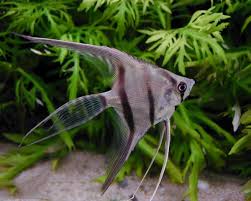Angel-Veiltail Large
Angel-Veiltail Large
check_circle Fast Shipping
check_circle Quality Products
check_circle Affordable Price
Reach out to us on ''available to order'' items via WhatsApp or email
Low stock: 2 left
Couldn't load pickup availability

Angel-Veiltail Large
package_2
Product Description
Product Description
Veiltail Angelfish (Pterophyllum scalare – Veil variety)
-
Scientific name: Pterophyllum scalare
-
Common name: Veiltail Angelfish
-
Family: Cichlidae
-
Origin: Amazon River Basin (South America); veil trait developed through selective breeding in captivity
-
Type: Freshwater, tropical fish
🔹 Appearance
-
Tall, laterally compressed (disc-shaped) body
-
Long, flowing dorsal, anal, and caudal (tail) fins — main “veil” feature
-
Body length: ~ 10–15 cm (4–6 in)
-
Total height (with fins): up to 20–25 cm (8–10 in)
-
Can appear in many colour morphs — silver, black, marble, koi, platinum, Paraiba, etc.
-
Graceful, slow-moving swimmer
🔹 Temperament & Behaviour
-
Generally peaceful, but territorial when breeding
-
Best kept in small groups when young; form pairs as adults
-
Avoid fin-nipping species (e.g. tiger barbs, serpae tetras)
-
Compatible with peaceful community fish like tetras, gouramis, corydoras, and dwarf plecos
🔹 Tank Requirements
-
Minimum tank size: 30 gallons (115 L) for a pair; taller tanks preferred
-
Temperature: 25–29 °C (77–84 °F)
-
pH: 6.0–7.5
-
Water hardness: Soft to moderately hard
-
Aquascape:
-
Tall plants and driftwood for cover
-
Gentle water flow to protect fins
-
Dim or soft lighting enhances colours
-
🔹 Diet
-
Omnivore — eats flakes, pellets, live or frozen foods (brine shrimp, bloodworms, daphnia)
-
Offer a varied diet to promote colour and fin health
-
Slow eater; ensure food isn’t stolen by faster fish
🔹 Breeding
-
Monogamous pairs form naturally
-
Lay eggs on flat surfaces (plant leaves, rocks, or slate)
-
Both parents usually guard eggs and fry
-
Veil trait is genetically dominant (V gene) — can be passed to offspring
🔹 Care Notes
-
Long fins are delicate — avoid sharp decorations
-
Sensitive to poor water quality — keep water clean and stable
-
Slow swimmer; avoid strong currents
-
Lifespan: typically 10–15 years with good care
✨ Key Features
-
Elegant, elongated fins
-
Calm, majestic swimming behaviour
-
Wide range of colour varieties
-
Symbol of grace in freshwater aquariums


